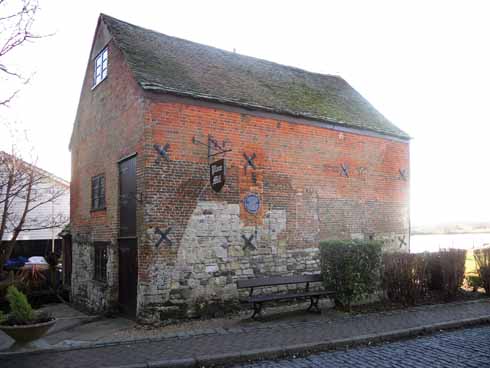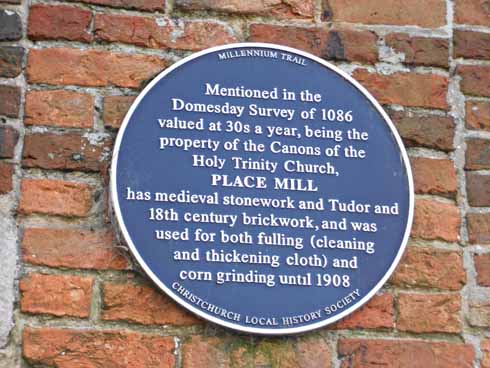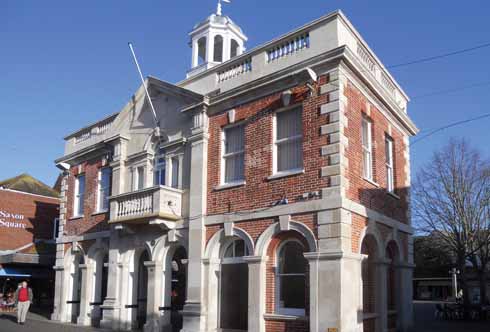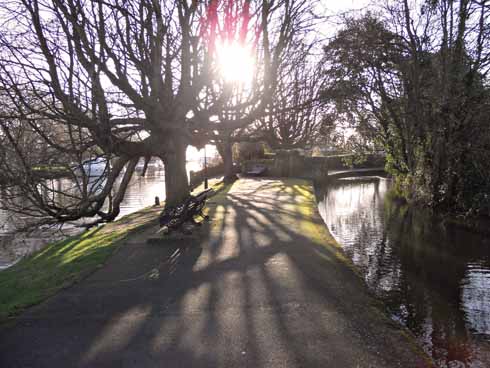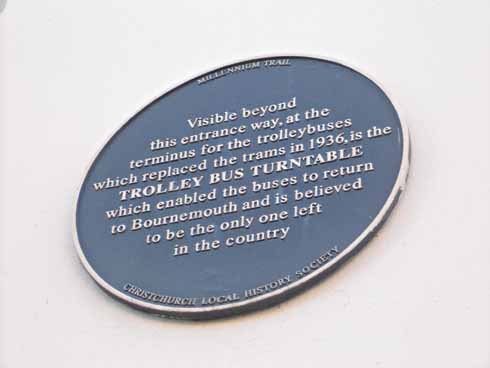‘All that remains’ – Christchurch’s blue plaques
Stephen Roberts takes us on a tour of Christchurch’s nineteen blue plaques and the vast range of history they celebrate
Published in November ’12
The northernmost blue plaque in Christchurch (1) – see map above, which lies metres to the north of the 1950s-built bypass, is the one commemorating the most ancient events. Occupation in Christchurch dates right back to Neolithic farmers and Bronze and Iron Age peoples, as evidenced by the workings on nearby Hengistbury Head (with the earliest records indicating occupation in 10,500 BC) which was eventually abandoned for Christchurch, as a more suitable site for human habitation. Digs under what is now the Waitrose Car Park revealed Neolithic pottery and the remains of Bronze Age round barrows and Iron Age ditches, a site then re-used by pagan Saxons for their own cemetery. The later Saxon cemetery contained over thirty burials and cremations, in which were found shield bosses, spears and knives.
The oldest human evidence on the ground today is Saxon. Christchurch was one of the Saxon burghs (fortified towns) established by Alfred the Great in the late 9th century to withstand Viking attack. Christchurch, thanks to its natural defences of the Rivers Avon and Stour, required a wall only across the neck of the promontory. (2) The second of our plaques in Wick Lane records the fact that part of these defences of banks and ditches was excavated near there. The best-preserved Saxon building in the town is Place Mill (3), down at the Town Quay. So called because it sits at the place between the waters of the River Avon and Stour, the mill is a Saxon site later recorded in the Domesday survey. The mill is unique, being the only freshwater tide-mill linking two main rivers. It was in use as a mill until 1908.
Sadly the Bargate (4) which would have been a prominent reminder of the town’s medieval defences is no more; it was removed in 1744. It is believed that it was built during the Hundred Years War because of the many coastal raids. It would have been an imposing structure, straddling the High Steet. The lost Bargate has left its own legacy, however, in the name ‘Bargates’, the road that runs north to the railway station. Moving from the High Street into Castle Street, the New Forest Perfumery (5), as well as being a favourite stop these days on the teapot trail, is also possibly this country’s oldest council house, dating back to the 13th century. This exquisite thatched building is sometimes mistakenly described as the ‘Old Court House’, which once stood next door in the gap now occupied by the town’s stocks and whipping post. The confusion may have arisen as court officials were elected in a back room of what is now the Perfumery.

Is this the country's first council house? The 13th-century 'Old Court House' is now the New Forest Perfumery
The Court officials were appointed for the coming year and these included a Hayward, who managed the Commons and the Pound (6), which was a pen for strayed animals. The Pound does not remain today but its name lives on in Pound Lane and its plaque states that it was a feature of the town for centuries, with its stone reputedly being taken from the old Bargate. The Pound was demolished to make way for the by-pass in 1958.
The Priory Courthouse (7), an early medieval courthouse where all transgressions for the Priory Manor were heard, stood behind a wall leading up to the gates to the Priory. By the 17th century it had been converted into two cottages, but these were eventually swept away and the site added to the vicarage garden. Back in Castle Street, wedged in between a phone shop and Lloyds Bank, is Ye Olde George Inn (8), formerly the George & Dragon. It still has its coaching-inn frontage, a throwback to the days when it was a stop for the ‘Emerald’, on the Lymington to Poole run. The inn was conveniently located for the original Market Square.
Turning around the corner by the phone shop and back into the High Street, a short walk brings us to the corner of Millhams Street and another of the town’s civic sites, the Old Tolsey (9), which was an earlier Town Hall than the current fine one, just beyond it. The first mention of an earlier municipal building here is in a deed of 1572 concerning a tenant, a tanner named William Nutkyn, describing it as the Old Tolsey (or Old Toll House); the plaque in Millhams Street shows where the building stood prior to its demolition in 1788.
(10) Castle Street’s third plaque is on the wall of Pettengells estate agents, formerly a 17th-century mercer’s house and later home of the talented Ferrey family, including George, who was the priory organist for 50 years and Benjamin, a famous ecclesiastical architect who carried out restoration work on over 50 church buildings, including Wells Cathedral, as well as some lay buildings amongst them Bournemouth’s illustrious Royal Bath Hotel.
(11) Bookends in the High Street is now, as the name suggests, a bookseller, but with artwork upstairs. This was the house which John Clingan gave in trust to benefit the poor, the trust income being used to fund apprenticeships for local children in occupations from dressmaking, carpentry and tailoring to a life at sea. Amazingly the trust, established in John Clingan’s will in or around 1716, still exists today, serves the same purpose and is still based in Christchurch in Bridge Street.
As you walk around the back of the Priory you come to the site of Priory House (12), built by Gustavus Brander, a naturalist who was a successful merchant and a director of the Bank of England. His leisure time was occupied in scientific pursuits and he became interested in fossils, a set of which he presented to the British Museum. Brander was elected a fellow of the Royal Society and was a trustee of the British Museum. Priory House‘s most famous visitor was Prince Louis Philippe, a future king of France.
The site of Robert Cox’s House (13) in the High Street (now Superdrug) is noteworthy as Cox gained a monopoly on fusée chain manufacture in Britain in 1793, supplying watch, clock and chronometer makers throughout the country. Some of these chains were so fine they could literally pass through the eye of a needle. Fusée chains were exported as far as America.
The Town Hall (14) dating from 1745 is now in the High Street. Christchurch has had its share of town halls, including the Old Tolsey and even the current Town Hall is not in its original location, having been moved from the old Market Square opposite the George in 1859. In 1902 there was a technical school behind the hall, which was converted to council offices before being finally demolished in 1979. The Town Hall was then restored with a mayor’s parlour on the first floor and a ground-floor market shelter, which is still used for tabletop sales. (15) The Red House Museum used to be the town’s workhouse. Most of the workhouse residents were unfit for work, but those who could were employed in making clothes and shoes, plaiting straw for bonnets and in fusée chain manufacture. It opened as a museum in 1951 and has an extensive collection of local history on display and is worth a visit not just for the exhibits, but also for the peaceful gardens.
Bow House (16) in the High Street (next to M&S) used to be part of the Christchurch Brewery buildings, the rest of which had been demolished by the 1970s for the car park behind M&S. Bow House stands on the line of the old Saxon wall, so would also have been in a line with the Bargate.
Returning to Bridge Street and then around the side and rear of the Priory, Convent Walk (17), which allows you to walk by the waters of the Avon with stunning views of Priory and Castle, was laid out just over a century ago in 1911 to celebrate the coronation of George V. The Regent Centre (18), Christchurch’s community arts centre, opened as a cinema in 1931 and an extension has been added at the rear as the Borough Council’s Millennium Project. Appropriately, given the unique history of Christchurch, we end with something unique to Christchurch. In Wick Lane, across from the Saxon Wall plaque, is another recalling the trolleybus turntable (19). You can still see the remains of the turntable in what was the yard of the Dolphin Hotel; it is believed to be the only one remaining in the whole of the UK. This was the terminus for the trolleybuses that came from Poole and Bournemouth, the last of which ran in 1969.

